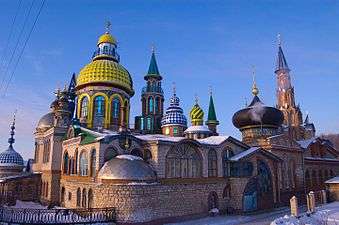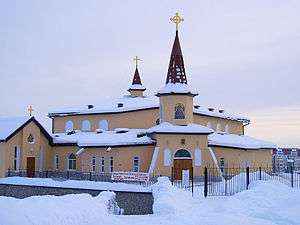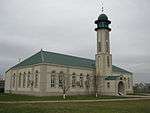Religion in Russia
Religion in Russia is diverse, with a 1997 law naming Christianity, Islam, Buddhism, and Judaism as important in Russian history. Orthodox Christianity (Russian: Православие Pravoslaviye) is Russia's traditional and largest religion, deemed a part of Russia's "historical heritage" in the law passed in 1997.[3] About 95% of the registered Orthodox parishes belong to the Russian Orthodox Church while there are a number of smaller Orthodox Churches.[4] Since the dissolution of the Soviet Union in 1991 there has been a wide spread of Siberian shamanism throughout Russia.[5]
Sociological approaches
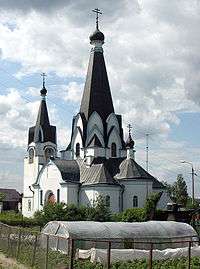
The ethnic approach is primarily useful when applied towards ethnic religious communities that are small and/or compact enough to be "left out" of normal public opinion polls. It based on an assumption that 100% of population of every ethnic minority are adherents of their group's traditional religion. A good example of such a religious community is Assyrian Church of the East, represented in Russia by ethnic Assyrians. With the body of followers of less than 15,000, it wouldn't show up or would fall within the margin of error on any reasonable religious self-identification poll, and its size can only be reasonably inferred from census data using the ethnic approach.
The ethnic approach is sometimes misused to artificially "inflate" prevalence of certain religions. For example, according to the Russian census of 2002, at least 14 million people in Russia belong to traditional Islamic ethnic groups, including registered migrants (Tatars, Bashkirs, etcetera). Consequently, it is often claimed that Islam has 14 million (or even 20-25 million) adherents in Russia.[6] However it should be noted that Russia does not have birth-right citizenship, and the children born to immigrants are not granted Russian passports. Also, among the traditional Islamic ethnic groups, there are large number of people who no longer practice Islam.[7]
One can get radically different results by estimating the number of observant followers of every religion, the reason being that members of many ethnic groups often choose to self-identify as adherents to a certain religion for cultural reasons, although they would not fit any traditional religiousness criteria (church attendance, familiarity with basic dogmas of their faith). For example, even though a majority of ethnic Russians self-identify as Russian Orthodox, less than 10% of them attend church services more than once a month and only 2-4% are considered to be integrated into church life (воцерковленные).[8] It is difficult to estimate observance of self-identified followers of other religions. The only faiths which are likely not to suffer from this phenomenon as strongly are those without ethnic basis in the country: most branches of Protestantism, Roman Catholicism, Hinduism and Krishnaism.
Yet another way of comparing relative popularity of various religions in Russia is to look at the numbers of registered local congregations (Christian parishes, Muslim mosques, and so on). According to the Ministry of Justice (MOJ), there were 21,664 registered religious organizations in Russia as of January 1, 2004, including 20,403 local congregations. 10,767 were Russian Orthodox; 3,397 were Muslim; almost 5,000 were various Protestant organizations and groups; 267 were Old Believers; 256 were Jewish; 235 were Roman Catholic; 180 were Buddhist. However, religions can vary significantly in numbers of followers per congregation, and some religions may be somewhat "under-registered" for various reasons.
One experiences similar problems when trying to determine the number of atheists in Russia. As discussed above, the majority of Russians are non-observant, and more than 50% never attend church services of any kind. On the other hand, numbers of those self-identifying as "non-religious" are much lower, and, further, vary wildly from poll to poll (from 14% to 36%).
Demography
In August 2012 the first-ever sociological survey and mapping of religious adherents in Russia based on self-identification was published in "Arena Atlas", with data on 79 out of 83 of the federal subjects of Russia.[1][9][10] Out of a population of 142,800,000 the survey found that 58,800,000 or 41% are Russian Orthodox, 9,400,000 or 6.5% are Muslims (including Sunni Islam, Shia Islam, Ahmadiyya Islam[11] and a majority of unaffiliated Muslims), 5,900,000 or 4.1% are unaffiliated Christians, 2,100,000 or 1.5% believe in Orthodox Christianity without belonging to any church or (a minority of the segment) belonging to other Orthodox Churches (including Ukrainian, Georgian, Armenian and other churches), 1,700,000 or 1.2% are pagans (including Rodnovery the "Slavic native faith", Ætsæg Din, Caucasian Neopaganism and Uralic Neopaganism) or Tengrists (Turco-Mongol shamanic religions and new religions), 700,000 or 0.5% are Buddhists (mostly Vajrayana), 400,000 or 0.2% are Orthodox Old Believers, 300,000 or 0.2% are Protestants, 140,000 or 0.1% are adherents of Hindus including Krishnaites, 140,000 are Catholics, 140,000 are Jews.[1][2] The Bahá'í Faith in Russia (Вера Бахаи), according to Association of Religion Data Archives was estimated at about 18,990 in 2005.[12] The remaining population is made up of 36,000,000 or 25% "spiritual but not religious" people, 18,600,000 or 13% atheist and non-religious people and 7,900,000 people or 5.5% of the total population who have deemed themselves "undecided".[1][2]
There is no official census of religion in Russia, and estimates are based on surveys only. In August 2012, ARENA[1] estimated that about 46.8% of Russians are Christians (including Orthodox, Catholic, Protestant, and non-denominational), which is slightly less than an absolute 50%+ majority. However, later that year the Levada Center estimated that 76% of Russians are Christians,[13] and in June 2013 the Public Opinion Foundation[14] estimated that 65% of Russians are Christians. These findings are in line with Pew Research Center's 2011 survey,[15] which estimated that 73.6% of Russians are Christians, with Russian Public Opinion Research Center (VTSIOM)'s 2010 survey (~77% Christian),[16] and with Ipsos MORI's 2011 survey (69%).[17]
The most recent European Social Surveys (ESS), from 2007 and 2009, found that 46% of the population of Russia declared itself non religious, 45% Eastern Orthodox, 8% Muslim, and the remaining belonged to other faiths.[18]
Ethnic demographics
Distribution of various religions among major ethnic groups in the Russian Federation (in percent):[1][19]
Note: <1 means between 0.5% and 1%, while <0.5 stands for 0.1% to 0.5%
| Ethnic Group | Russ. Orth. | Oth. Orth. | Old Believer | Protestant | Catholic | Pentecostal | Christ. Unff. | Non-religious | Atheist | Muslim Unff. | Sunni Musl. | Shia Musl. | Pagan / Tengrist | Buddhist | Judaism | Hindu |
|---|---|---|---|---|---|---|---|---|---|---|---|---|---|---|---|---|
| Total | 41.1 | 1.5 | 0.3 | 0.2 | 0.1 | 0.1 | 4.1 | 25.2 | 13.0 | 4.7 | 1.7 | 0.2 | 1.2 | 0.5 | 0.1 | 0.1 |
| Russian | 46 | 1.5 | <1 | <1 | 0 | 0 | 4.3 | 27 | 14 | 0 | 0 | 0 | <1 | 0 | 0 | 0 |
| Tatar | 5 | <1 | 0 | 0 | 0 | 0 | 1 | 17 | 9 | 55 | 3 | 1.3 | 1.6 | 0 | 0 | <1 |
| Ukrainian | 45 | 2 | <1 | <1 | <1 | 0 | 7 | 26 | 12 | <1 | 0 | 0 | <1 | 0 | 0 | 0 |
| Chuvash | 58 | 4 | <1 | 0 | 0 | 0 | 2 | 22 | 8 | 0 | <1 | 0 | 2 | 0 | 0 | 0 |
| Bashkir | 1 | 0 | 0 | <1 | <1 | 0 | 1 | 25 | 11 | 43 | 6 | <1 | 2 | <1 | 0 | <1 |
| Armene | 35 | 7 | 0 | 0 | 1.8 | 0 | 13 | 25 | 7 | 1 | <1 | 0 | <1 | 0 | 0 | 0 |
| Avar | 2 | 0 | 0 | 0 | 0 | 0 | 0 | 5 | 2 | 24 | 66 | <1 | 1.2 | 0 | 0 | 0 |
| Mordvin | 60 | 0 | 0 | 0 | 0 | 0 | 7 | 14 | 12 | 0 | 0 | 0 | <1 | 0 | 0 | 0 |
| German | 18 | 2 | 0 | 3.2 | 7.2 | 1.2 | 5 | 34 | 18 | 0 | 0 | 0 | 2 | 0 | 0 | 0 |
| Jews | 13 | 0 | 0 | 0 | 0 | 0 | 4 | 25 | 27 | 0 | 0 | 0 | 3 | 4 | 13 | 0 |
| Kazakh | 3 | 0 | 0 | 0 | 0 | 0 | 1 | 14 | 7 | 54 | 7 | 1.1 | 5.9 | 0 | 0 | <1 |
| Belarusian | 46 | 4.6 | 1.4 | <1 | 1.3 | 0 | 3 | 20 | 15 | 1 | 0 | 0 | 0 | 0 | 0 | <1 |
Religions
Russian Orthodoxy
The ancestors of many of today’s Russians adopted Orthodox Christianity in the 10th century.[20] The Church claimed a membership of 80 million in 2005.[21] According to a 2007 poll by the Russian Public Opinion Research Center, 63% of respondents considered themselves Russian Orthodox.[22] In a 2011 survey by the Levada Center, the number of people self-identifying as Russian Orthodox has been on a steady increase from 31% in 1991, to 50% in 2001, and to nearly 70% in 2011.[23]
As of a 2012 sociological survey on religious adherence, 58,800,000 people or 41% of the total population of Russia adhere to the Russian Orthodox Church. It is the religion of 21% to 40% of the population in most of the federal subjects of Russia, 41% to 60% in a group of them mostly in Western Russia (including Yamalia and Perm Krai), and over 60% in Kursk Oblast (69%), Voronezh Oblast (62%), Lipetsk Oblast (71%), Tambov Oblast (78%), Penza Oblast (63%), Ulyanovsk Oblast (61%), Mordovia (69%) and Nizhny Novgorod Oblast (69%).[1][2]
In cultural and social affairs President Vladimir Putin has collaborated closely with the Russian Orthodox Church. Patriarch Kirill of Moscow, head of the Church, endorsed Putin's election in 2012. Steven Myers reports, "The church, once heavily repressed, had emerged from the Soviet collapse as one of the most respected institutions....Now Kiril led the faithful directly into an alliance with the state."[24] Mark Woods provides specific examples of how the Church under Kirill has backed the expansion of Russian power into Crimea and eastern Ukraine.[25] More broadly the New York Times reports in September 2016 how that Church's policy prescriptions support the Kremlin's appeal to social conservatives:
- A fervent foe of homosexuality and any attempt to put individual rights above those of family, community or nation, the Russian Orthodox Church helps project Russia as the natural ally of all those who pine for a more secure, illiberal world free from the tradition-crushing rush of globalization, multiculturalism and women’s and gay rights.[26]
Roman Catholicism
The Catholic Church is the religion of 140,000 Russian citizens, thus about 0.1% of the total. It is concentrated in Western Russia with numbers ranging between 0.1% and 0.7% in most of the federal subjects.[2]
The Archdiocese of Moscow is the archbishopric of the Latin rite of the Catholic Church in Russia. Further suffragan bishoprics exist in Irkutsk, Novosibirsk and Saratov. The Diocese of Irkutsk is in fact the largest Catholic bishopric on earth, covering an area of 9,960,000 km2.
Almost all Russian Catholics adhere to the Latin rite. However, the Catholic Church recognizes the Russian Greek Catholic Church as a Byzantine Rite church sui juris in full communion with the Catholic Church. It is extremely small, with just a few parishes in the entire world.
Other Christians
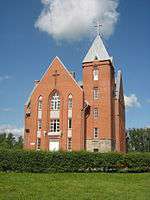
Orthodox Christian believers unaffiliated to any church or a minority of people affiliated to non-Russian Orthodox churches (including the Ukrainian Orthodox churches, the Georgian Orthodox Church, the Armenian Apostolic Church, etcetera), comprise together 1.5% (2,100,000) of the total population of Russia. Minor orthodox churches are represented among ethnic minorities of Ukrainian Russians, Georgian Russians and Armenian Russians. Unaffiliated Orthodox and minoroties of non-Russian Orthodox believers comprise over 4% of the population in Tyumen Oblast (9%), Irkutsk Oblast (6%), the Jewish Autonomous Oblast (6%), Chelyabinsk Oblast (5%), Astrakhan Oblast (4%) and Chuvashia (4%).[1][2]
The Old Believers constitute 0.2% (400,000) of the total population of the country, but their numbers heighten to 1% and over in Smolensk Oblast (1.6%), Altay (1.2%), Magadan Oblast (1%) and Mari El (Marelia) (1%).[2]
As of 2015 Jehovah's Witnesses is the religion of 0.12% (175,000) of the peoples of Russia.[27]
Protestantism in various denominations, both historical and Evangelical or Pentecostal, is the religion of 0.2% (300,000) of the peoples of Russia. Their number is 1% or over only in Tuva (1.8%), Udmurtia (1.4%) and Altay (1%). Russia is considered by some observers to experience a Protestant revival in the future.[28][29][30]
Unaffiliated generic "Christians" form 4.1% (5,900,000) of the total population of Russia, with numbers ranging between 1% to 8% in most of its federal subjects, and over 8% only in Nenetia (14%), North Ossetia–Alania (10%), Tver Oblast (9%) and the Jewish Autonomous Oblast (9%).[2] Vissarionism is a new syncretic religious movement based on Christian and Eastern religious ideas, which has a small following in southern Krasnoyarsk. Its leader, Vissarion, claims to be a reincarnation of Jesus.
Islam

Islam is the second largest religion in Russia after Russian Orthodoxy.[31] It is the traditional or predominant religion amongst some Caucasian ethnicities (notably the Chechens, the Ingush and the Adyghe), and amongst some Turkic peoples (notably the Tatars, the Bashkirs).
Altogether, Muslims in Russia are 9,400,000 or 6.5% of the total population as of 2012 (however, ARENA survey didn't include detailed data for the traditionally Islamic states of Chechenia and Ingushetia). Notwithstanding, various differences split the Muslim population in different groups. According to the survey, most of the Muslims (precisely 6,700,000 or 4.6% of the total population) are "unaffiliated" to any Islamic schools and branches or Islamic organisation, this is mainly because it is not essential for Muslims to be affiliated with any specific sect or organization. Those who are unaffiliated are mostly Sunni Muslims. These unaffiliated Muslims constitute significant percentages of over 10% in Kabardino-Balkaria (49%), Bashkortostan (38%), Karachay-Cherkessia (34%), Tatarstan (31%), Yamalia (13%), Orenburg Oblast (11%), Adygea (11%) and Astrakhan Oblast (11%). Most of the regions of Siberia have an unaffiliated Muslim population of 1% to 2%.[1][2]
Sunni Islam is the religion of 2,400,000 of the Muslims, or 1.6% of the total population of Russia. It has significant following of more than 10% of the population only in Dagestan (49%) and Karachay-Cherkessia (13%). Percentages higher than 2% are found in Kabardino-Balkaria (5%), Yugra (Khantia-Mansia) (5%), Yamalia (4%), Astrakhan Oblast (3%), Chelyabinsk Oblast (3%) and Tyumen Oblast (2%). Yakutia has a population of Sunnis ranging between 1% and 2%. Many other federal subjects have a Muslim population of 0.1% to 0.9%.[1][2]
Shia Islam is a minority of 300,000 people (0.2% of the total population of Russia). It is primarily represented in Dagestan (2%), Adygea (1%), Karachay-Cherkessia (1%), Kabardino-Balkaria (1%), Novgorod Oblast (1%), Penza Oblast (1%), Tatarstan (1%) and Yugra (1%).[2] Russia has an estimated 3 million to 4 million Muslim migrants, both legal and illegal, from the ex-Soviet states.[32]
Ahmadiyya Islam is a small, but active minority in Russia.[11]
Thence, the federal subjects of Russia with an absolute majority (more than 50%) of Muslims are Chechenia, Ingushetia, Dagestan (82.6%), and Kabardino-Balkaria (55.4%). Significant percentages (over 5%) can be found in Karachay-Cherkessia (48.0%), Bashkortostan (38.6%), Tatarstan (33.7%), Yamalia (17.4%), Astrakhan Oblast (14.6%), Adygea (12.6%), Orenburg Oblast (13.9%) and Yugra (10.9%).[1][2]
Native faiths and Tengrism
.png)
Modern "pagan" religions and Tengrism counted together as "traditional religions of the ancestors"[9] are represented by 1.700.000 followers or 1.2% of the total population of Russia, thus constitute the third-largest religious group after Christianity and Islam.[1] Tengrism is a term defining the traditional ethnic and shamanic religions of the Turkic and Turco-Mongol peoples, and modern movements reviving them started amidst the Turkic and Turco-Mongol nations within Russia. Modern paganism in Russia is primarily represented by the revival of the ethnic religions of the Russians (Slavic), the Ossetians (Scythian), but also by those of some Caucasian and Finno-Ugric ethnic minorities of Russia.
Rodnovery (the "Slavic native faith") alone represents 44% (~ 750,000) of the total number of the followers of the "traditional religions of the forefathers".[9] All these ethnic religions are defended under the 1997 law on religion, which pronounces that protection has to be accorded to "ancient Pagan cults, which have been preserved or are being revived in the Komi Republic, Mari-El, Udmurtia, Chuvashia, Chukotka and several other subjects of the Russian Federation".[33][34]
Caucasian Neopaganism, Ætsæg Din (Osset Neopaganism) and Rodnovery are primarily represented by significant followings in North Ossetia–Alania (29%), Karachay-Cherkessia (12%), Kabardino-Balkaria (3%), Orenburg Oblast (over 3%), Kemerovo Oblast (over 3%), 2% to 3% in Dagestan, Astrakhan Oblast, Kaluga Oblast, Tyumen Oblast, Irkutsk Oblast and Magadan Oblast. Slavic Rodism is also present in many of the federal subjects of Western Russia in percentages ranging between 1% and 2%.[1][2] Caucasian Neopagans are primarily many Circassians practice their indigenous faith, called Circassian Habze.
The first Rodnover association in Russia was registered in 1994. Rodnover groups in the Russian Federation include the Slavic Communities Union based in Kaluga. The largest worship cult is that of Rod. Lesser deities include Perun and Dazhbog. Russian centers of Rodnovery are situated also in Dolgoprudny, Pskov and other cities. Moscow has several pagan temples.[35]
Uralic Neopaganism is practiced by the Finno-Ugric ethnic minorities of Russia (primarily the Mari, the Mordvins, the Udmurts and the Komi). The Mari Traditional Religion is practiced by 6% of the population of Mari El according to the 2012 survey.[2] Other studies report higher percentages (15%).[36] Paganism is practiced by between 2% and 3% of the population of Udmurtia (Udmurt Vos, Udmurt Neopaganism) and the Perm Krai, and between 1% and 2% of the population of the Komi Republic.[1][2] Uralic Pagan movements can be found amongst the other Finno-Ugric nations of Russia, for example the Mordvin Native Religion in Mordovia.
Pagans have faced violence in many parts of Russia, especially in Muslim dominated areas. Aslan Tsipinov, one of the main advocates for Circassian Habzism in Kabardino-Balkaria was murdered by Islamists in 2010.[37] Just months before his death, Tsipinov was ordered by the radicals to stop popularizing Circassian (Kabardian) Pagan rituals.[38] Practitioners of the Mari Traditional Religion, often referred as the "Europe's last Pagans" also face widespread harassment from the government officials.[39] However, in regions such as Abkhazia (part of the Caucasus, but outside Russia) and South Ossetia, Paganism enjoys widespread support from the majority population.[40] In North Ossetia–Alania, the Pagans accounted for as much as 30% of the ethnic Ossetian population in a 2002 survey, 20.3% in a 2006 survey,[41] and 29% of the total state population (including non-ethnic Ossetians) in 2012.
Tengrism and Turco-Mongol shamanic religions are found primarily in Siberia and the Russian Far East. About 13% of the inhabitants of Altay adhere to such religions (including Burkhanism), 13% of the population of Yakutia (28.2% according to another survey[42]), 8% of Tuva, 3% of Kalmykia, between 2% and 3% of Khakassia, Buryatia and Kamchatka.[1][2] The survey excluded detailed data on Chukotka with a large population of Chukchi shamanists. Vattisen Yaly is practiced by ethnic Chuvash in Chuvashia.
Ynglism is a Neopagan religion centered in Omsk but with communities spread throughout Russia, variously classified as a branch of Rodnovery, but often not recognised as such by mainstream Rodnover groups. The religion was organised into a church body in 1992 and was officially registered in Omsk in 1998; its leader hitherto is Aleksandr Hinevich.
Buddhism


Buddhism is practiced by 700,000 people in Russia, or 0.5% of the total federal population.[1] Other recent estimates place the number as high at 2 million, or about 1.4% of the population, when counting Buddhism and combined syncretic practices.[43] It is present almost exclusively in its Tibetan Vajrayana schools. It is the traditional religion amongst some Turkic and Mongolic ethnicities in Russia (Kalmyks, Buryats and Tuvans). It is the religion of the 62% of the total population of Tuva, 38% of Kalmykia and 20% of Buryatia.[2]
It also has a following of 6% in Zabaykalsky Krai, primarily consisting in ethnic Buryats, and of 0.5% to 0.9% in Tomsk Oblast and Yakutia. Buddhist communities can be found in other lands of Russia, between 0.1% and 0.5% in Sakhalin Oblast, Khabarovsk Krai and Amur Oblast, in Irkutsk Oblast, Altay, Khakassia, Novosibirsk Oblast, Tomsk Oblast, Tyumen Oblast, Orenburg Oblast, Arkhangelsk Oblast, Murmansk Oblast, Moscow and Moscow Oblast, Saint Petersburg and Leningrad Oblast, and in Kaliningrad Oblast.[1][2]
Hinduism
Krishnaism, Tantric practices, Vedic practices and broader Hinduism have gathered a following among Russians mostly through missionary work carried out by the International Society for Krishna Consciousness, the Brahma Kumaris, the Tantra Sangha and other groups. Moreover, forms of indigenous Hindu movements (called "Slavic Vedism") have sprung up, with ties to Slavic Neopaganism.[44] These movements have been fueled by the growth of interest in the common Indo-European roots of Europe and India — being Russia a place of particular importance regarding the origins of the Indo-European peoples —, and the 2007 excavation of an ancient Vishnu idol in the Volga region.[45] Russian Vedists and Hindus have established several temples across the country, including the Temple of the Seven Rishi[46] and the planned large Hindu temple in Moscow.
Hinduism in Russia is practiced by 140,000 people or 0.1% according to the 2012 survey. It constitutes 2% of the population of Altay, 0.5% in Samara Oblast, 0.4% in Khakassia, Kalmykia, Bryansk Oblast, Kamchatka, Kurgan Oblast, Tyumen Oblast, Chelyabinsk Oblast, 0.3% in Sverdlovsk Oblast, 0.2% to 0.3% in Yamalia, Krasnodar Krai, Stavropol Krai, Rostov Oblast, Sakhalin Oblast, and 0.1% to 0.2% in other federal subjects.[1][2]
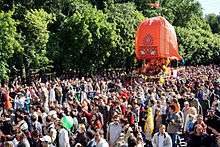
Bhagavad Gita trial
| Wikinews has related news: Indian Parliament irate as Russia poised to ban Bhagavad Gita |
| Wikinews has related news: Russian court rejects move to ban Hindu scripture |
A group linked to the Christian Orthodox Church had demanded a ban of Bhagavad Gita owing to conflict of interests between the Russian followers of Krishna and the local authorities in Tomsk Oblast. The case was dismissed by the federal judge on 28 December 2011.[47]
Russian ambassador Alexander Kadakin condemned the "madmen" seeking the ban, said the following underlining that Russia was a secular country:[48]
| “ | Russia is a secular and democratic country where all religions enjoy equal respect... Even more applicable it is to the holy scriptures of various faiths -- whether it is the Bible, the Holy Quran, Torah, Avesta and, of course, Bhagvad Gita -- the great source of wisdom for the people of India and the world. | ” |
After the ban, 15,000 Indians in Moscow, and followers of the Iskcon in Russia appealed to the Indian government to intervene to resolve the issue.[49] The move triggered strong protests by Members of Parliament as they wanted the Indian Government to take up the matter strongly with Russia. The final hearing in the Tomsk district court was then scheduled on 28 December, after the court agreeing to seek the opinion of the Russian Ombudsman on human rights in Tomsk Oblast and of Indologists from Moscow and St Petersburg.[50]
Judaism

There are 140,000 practicing Jews in Russia as of 2012, with a larger ethnic Jewish population (500,000). They are mostly concentrated in Kamchatka Krai (0.4%), Saint Petersburg (0.4%), Kursk Oblast (0.4%), Khabarovsk Krai (0.3%), Stavropol Krai (0.3%), Buryatia (0.2%), the Jewish Autonomous Oblast (0.2%), Kalmykia (0.2%) and Kabardino-Balkaria (0.2%).[1][2]
Taoism
Taoism has been transmitted into Russia after the fall of the Soviet Union particularly through the work of Master Alex Anatole, a Russian himself and Taoist priest, founder of the Center of Traditional Taoist Studies, active in Moscow since 2002. Other branches active in Russia are Wuliu Taoism and Zhendao Taoism. Since September 2007 there is an officially functioning school of the Wuliu branch in Saint Petersburg, and there are chapters in other cities. Zhendao Taoism has been introduced to Russia by the Ukrainian Master Vitaly Lyschina.
See also
- Religion in the Soviet Union
- Anti-Semitism in Russia
- Anti-Semitism in the Soviet Union
- Bahá'í Faith in Russia
- Buddhism in Russia
- Christianity in Russia
- History of the Jews in Russia
- Irreligion in Russia
- List of tallest Orthodox churches
- Persecution of Christians in the Soviet Union
- Scientology in Russia
- Slavic Neopaganism
References
- 1 2 3 4 5 6 7 8 9 10 11 12 13 14 15 16 17 18 19 Arena - Atlas of Religions and Nationalities in Russia. Sreda.org
- 1 2 3 4 5 6 7 8 9 10 11 12 13 14 15 16 17 18 19 20 2012 Survey Maps. "Ogonek", № 34 (5243), 27/08/2012. Retrieved 24-09-2012.
- ↑ Bell, Imogen. Eastern Europe, Russia and Central Asia. Retrieved 2007-12-27.
- ↑ "Сведения o религиозных организациях, зарегистрированных в Российской Федерации По данным Федеральной регистрационной службы" (in Russian). December 2006. Retrieved 2007-12-27.
- ↑ Kharitonova, Valentina (2015). "Revived Shamanism in the Social Life of Russia". Folklore. FB and Media Group of LM. 62. doi:10.7592/FEJF2015.62. ISSN 1406-0949.
- ↑ "Fact Box: Muslims In Russia". Rferl.org. Retrieved 2014-04-20.
- ↑ "Готовы ли русские жить по шариату". Online812.ru. Retrieved 2014-04-20.
- ↑ "Как пишутся страшные сказки о Церкви". Rusk.ru. 2005-08-31. Retrieved 2014-04-20.
- 1 2 3 Olga Filina (Ogonek Magazine). Mapping Russia's Religious Landscape. Russia and India Report. Retrieved 24-09-2012.
- ↑ Верю — не верю. "Ogonek", № 34 (5243), 27/08/2012. Retrieved 24-09-2012.
- 1 2 Ingvar Svanberg, David Westerlund. Islam Outside the Arab World. Routledge. p. 418. ISBN 0-7007-1124-4. Retrieved June 27, 2014.
- ↑ "Most Baha'i Nations (2005)". QuickLists > Compare Nations > Religions >. The Association of Religion Data Archives. 2005. Retrieved 2010-05-03.
- ↑ http://www.levada.ru/17-12-2012/v-rossii-74-pravoslavnykh-i-7-musulman Levada Center
- ↑ http://fom.ru/obshchestvo/10953 Public Opinion Foundation
- ↑ http://www.pewforum.org/2011/12/19/global-christianity-exec/ Pew
- ↑ http://wciom.ru/index.php?id=268&uid=13365 VTSIOM
- ↑ http://www.fgi-tbff.org/sites/default/files/elfinder/FGIImages/Research/fromresearchtopolicy/ipsos_mori_briefing_pack.pdf#page=40 Ipsos MORI
- ↑ European Social Surveys 2007-2009.
- ↑ "Арена в PDF : Некоммерческая Исследовательская Служба "Среда"". Sreda.org. Retrieved 2014-04-20.
- ↑ Microsoft Encarta Online Encyclopedia 2007. Russia. Retrieved 2007-12-27.
- ↑ Page, Jeremy (2005-08-05). "The rise of Russian Muslims worries Orthodox Church". The Times. London. Retrieved 2010-05-22.
- ↑ Опубликована подробная сравнительная статистика религиозности в России и Польше (in Russian). religare.ru. 6 June 2007. Retrieved 2007-12-27.
- ↑ Levada Center: Religious Faith in Russia" September 26, 2011 (in Russian)
- ↑ Myers (2016). The New Tsar. p. 404.
- ↑ Mark Woods, "How the Russian Orthodox Church is backing Vladimir Putin's new world order" Christian Today March 3, 2016
- ↑ Andrew Higgins, "In Expanding Russian Influence, Faith Combines With Firepower," New York Times Sept 13, 2016
- ↑ 2016 Yearbook of Jehovah’s Witnesses
- ↑ "Moscow Church Spearheads Russia Revival". Retrieved 14 February 2015.
- ↑ Protestantism in Postsoviet Russia: An Unacknowledged Triumph
- ↑ Felix Corley and Geraldine Fagan. "Growing Protestants, Catholics Draw Ire". ChristianityToday.com. Retrieved 14 February 2015.
- ↑ Marshall Cavendish; Google Books (2010). World and Its People. books.google.com. pp. 1,387. ISBN 978-0-7614-7883-6.
- ↑ "Russia: CIS Migrants". Migration.ucdavis.edu. Retrieved 2014-04-20.
- ↑ Martin W. Lewis. The Survival of Animism in Russia – and Its Destruction in the West. Geocurrents, 2011. Retrieved 07-10-2012.
- ↑ Mari Paganism: Traditional Religion or Destructive Cult?. Religioscope, 2002. Retrieved 07-10-2012.
- ↑ Московская Славянская Языческая Община. Rodoslav , Smagoslav, et al. Moscow Slavic Pagan Community. Slavic Paganism. 2001-6-22. Accessed 2011-12-27.
- ↑ Nikolaus von Twickel. Europe's Last Pagans Worship in Mari-El Grove. Saint Petersburg Times, 2009.
- ↑ North Caucasus Insurgency Admits Killing Circassian Ethnographer. Caucasus Report, 2010. Retrieved 24-09-2012.
- ↑ Valery Dzutsev. High-profile Murders in Kabardino-Balkaria Underscore the Government’s Inability to Control Situation in the Republic. Eurasia Daily Monitor Volume: 8 Issue: 1,2011. Retrieved 24-09-2012.
- ↑ Geraldine Fagan. Soviet anti-religion has returned, claim Europe's last surviving pagans. odRussia, 2010. Retrieved 24-09-2012.
- ↑ Язычество в Абхазии не станет государственной религией - Paganism in Abkhazia will be the state religion. Newsland, 12-08-2012. Retrieved 24-09-2012.
- ↑ Религиозная жизнь современной Северной Осетии - The religious life in modern North Ossetia. Retrieved 24-09-2012.
- ↑ Современная религиозная ситуация в Республике Саха (Якутия): проблемы и перспективы. religare.ru
- ↑ "Russia". State.gov. Retrieved 2014-04-20.
- ↑ Michael Strmiska. Modern Paganism in World Cultures. Chapter Six: The Revival of Ukrainian Native Faith by Adrian Ivakhiv. pp. 209-239.
- ↑ Ancient Vishnu idol found in Russian town. Times of India 4 Jan 2007
- ↑ "Храма Семи Риши". 7rishi.advayta.org. 2011-08-19. Retrieved 2014-04-20.
- ↑ "Gita row: Russia court refuses to ban Bhagvad Gita". NDTV. 28 December 2011. Retrieved 28 December 2011.
- ↑ "Declare Bhagavad Gita as national book, demands BJP". Hindustan Times. 20 December 2011. Archived from the original on 20 December 2011. Retrieved 20 December 2011.
- ↑ "20 DEC, 2011, 03.49PM IST, IANS Gita row snowballs, India raises issue at 'highest levels'". The Economic Times. 20 December 2011. Retrieved 20 December 2011.
- ↑ "Gita ban: Russian court suspended verdict till 28 Dec". The Statesman. 19 December 2011. Retrieved 20 December 2011.
External links
| Wikimedia Commons has media related to Religion in Russia. |
- International Religious Freedom Report 2007: Russia
- Statistics of Russian Religiousness (Russian)
- Confessional Structure of Russian Population (Russian)
- Registered Religious Organizations as of January 1, 2004; Ministry of Justice data (Russian)
- Secular State and Islamic Tradition in Russia
- Russia has a Muslim dilemma (article in San Francisco Chronicle)
- Muslims In Russia
- Islam to become Russia’s predominant religion by 2050?
- Religious minorities in Russia and Lithuania (Russian)
- The Relations Triangle: Islam, Russian Orthodox Church and the State in Post-communist Russia
-
 Herbermann, Charles, ed. (1913). "The Religion of Russia". Catholic Encyclopedia. New York: Robert Appleton Company.
Herbermann, Charles, ed. (1913). "The Religion of Russia". Catholic Encyclopedia. New York: Robert Appleton Company.

.jpg)


